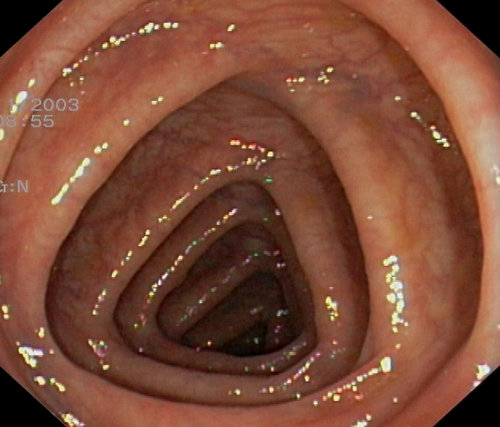Splenic Flexure Syndrome
Last reviewed by Dr. Raj MD on January 12th, 2022.
Splenic flexure syndrome
Splenic flexure syndrome describes gas, bloating, and muscle spasms in the colon and or discomfort in the upper abdominal area.
It has been considered a type of IBS (Irritable bowel syndrome). The gas that is found in the colon is a mix between that which is swallowed and that which the intestine makes. (1,2)

Image 1 : Here you can see the curve between the transverse and descending colon.
Photo Source : healthylifemed.com
Symptoms
- Bloating
- upper abdominal pain
- gas movement, flatulence or belching
- chest pain (similar to cardiac pain)
- The pain is usually severe and lasts a couple of hours.
- Some patients have expressed shortness of breath or palpitations.
- The pain may change or get better depending on the position of the patient but usually, there is not one position in which the pain completely goes away.
- Abdominal distention
- Abdominal spasms
- At times fever can be noted
- Diarrhea
- Presence of a palpable mass(1,2, 6)
Causes
External:
- Stress
- aggressive or overconfident character
- eating too fast and swallowing air
- lack of exercise
- lack of fiber in the diet
- Eating foods considered ass short-chained carbohydrates such as legumes, Brussel sprouts, apples, and sweet cherries.
- Food poisoning
- Excessive alcohol intake
- Excessive intake of complex sugars. (1, 3, 6)
Internal:
- Gas build up in the gastric system
- pressure on other organs
- inflammation in the colon
- obstruction in the intestines
- Abdominal adhesion
- Ulcerative colitis
- Digestive infections
- Crohns disease
- Slowed intestinal contractions. (1,2,6)
 Photo 2 : This image shows each part of the colon in different colors.
Photo 2 : This image shows each part of the colon in different colors.
Picture Source : www.medicalartlibrary.com
Diagnosis
- Upon physical examination, tympanic percussion or tapping over the affected area may reveal air or gas. This will be evident by a hollow drum-like sound.

Figure 3 : This image shows the areas in which the pain from splenic flexure may be felt.
Photo Source : www.healthhype.com
- Radiologic exams will also show swelling in the area with gas or air being shown in the results.
- Barium contrast studies have been proven to not be helpful in the diagnosis of splenic flexure syndrome.
- A lower GI colonoscopy is a better way to look closely at the colon and its structures.

Image 4 : The passage of the splenic flexure during a routine colonoscopy.
Picture Source : www.endoscopy-colon-explorer.com
- 24-hour diary of food intake
- Differential diagnosis must rule out many possibilities. This is a limited list of the diagnosis or issues that must be ruled out: Constipation, herpes zoster, sickle cell crisis, splenic abscess, spleen hematoma, splenic infarct, kidney contusion, primary spleen sarcoma, spleen hematoma, subphrenic abscess, nonspecific splenetic, perinephric abscess, intestinal or bowel obstruction, kidney stones. (2,3, 6)

Photo 5 : this image shows how the lower GI colonoscopy is done and how the doctor can monitor the inside of the colon.
Picture Source : howshealth.com
Treatment
- Educating the patient that there is no serious underlying disease process.
- Antispasmodic
- antidepressant medications
- Antacids
- Beano
- Metoclopramide
- Encourage stool and gas passing
- Dietary changes. (2, 6)
Anatomy of the colon
- 5-6 feet long
- It has an inverted U shape
- Three sections are the ascending, transverse and descending colon.
- Receives its blood supply from the mesenteric artery.
- Made of three layers of tissue the mucosa, submucosa and muscular Propecia. (3)

Figure 6 : This image was chosen in order to show the blood supply to the colon.
Image Source : cephalicvein.com

Photo 7 : Here you can see the areas of the colon and how it has the shape of an upside down U.
Picture Source : img.medscapestatic.com
Splenic flexure syndrome diet
- Decrease in gas causing foods
- Decrease in sodium or salty foods
- Increase in potassium rich foods
- Increase intake of natural fiber
- Increase in fluid intake (6)
What is Splenic Flexure?

Picture 8 : What is the splenic flexure. It is basically the bend of the colon between the transverse and the descending colon. It lies near the spleen.
Photo Source : byebyedoctor.com
What is Hepatic Flexure Syndrome?
The image above also shows the hepatic flexure. This syndrome has the same symptoms causes and treatments as the splenic flexure syndrome. The difference is that the gas build up is in the hepatic flexure, therefore, placing the pain and discomfort on the right side instead of the left.
FAQ
What is a hepatic flexure polyp? A polyp is simply a tag of skin in an area that usually does not have one. In this case, the polyp would be noted in the hepatic flexure. This may cause problems with movement of feces through the colon.
What is a mobilization of splenic flexure? This is a laparoscopic technique used to better see and therefore diagnosis issues with the colon. It has been said that it helps to better view the mesenteric artery and the mesenteric windows. (9, 10)
Here is a video that shows the mobilization technique.
https://www.youtube.com/watch?v=bZG2il8_8fM
What is the hepatic flexure in the colon?
The hepatic flexure is the bend between the ascending and transcending colon. It lays near the liver which is where it got the name hepatic.
In conclusion splenic flexure syndrome is gas build up in the area of the colon called the splenic flexure. It is relieved by manipulation and anti-gas treatment. Many other diagnosis must be ruled out before giving this diagnosis to be sure the correct treatment is prescribed.
Resources:
- https://en.wikipedia.org/wiki/Splenic_flexure_syndrome
- https://www.ncbi.nlm.nih.gov/pmc/articles/PMC2482946/?page=2
- https://www.hxbenefit.com/splenic-flexure-syndrome.html
- https://www.ncbi.nlm.nih.gov/pmc/articles/PMC5044920/
- http://emedicine.medscape.com/article/1948863-overview
- https://www.hxbenefit.com/splenic-flexure-syndrome.html
- http://emedicine.medscape.com/article/1948863-overview#a2
- http://syndromespedia.com/splenic-flexure-syndrome-symptoms-treatment.html#.WNFVxW_yvDd
- http://emedicine.medscape.com/article/1965584-technique
- https://www.ncbi.nlm.nih.gov/pmc/articles/PMC2727804/